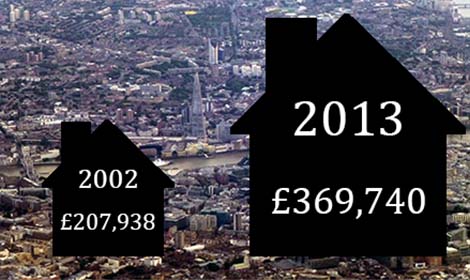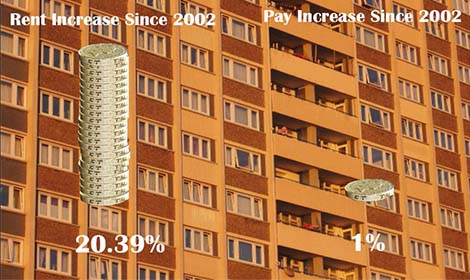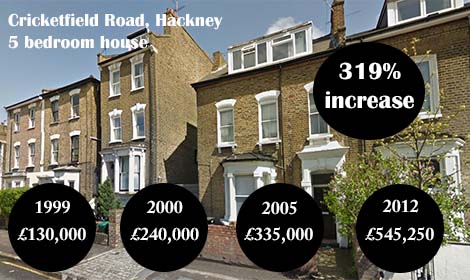East London’s housing crisis: gentrification and price rise
04-28-2014
Posted by: Eastlondonlines Filed under: Features,General Features
Average London House Price change between 2002 and 2013 pic: McCarthy-Rimella
It’s no surprise that house prices in London are on the upswing. Prices have been going up every year since the housing bubble burst in 2008 and overall, in London, prices have almost doubled in the last decade – a trend that isn’t likely to stop anytime soon.
A December report by Oxford Economics, on behalf of the National Housing Federation, forecasted that the average cost of a London home will go up by more than 40 per cent in the next six years to almost £650,000, pushing first time buyers and low-income earners out of the market.
A shortage of new homes is often quoted as the driving force behind the trend, but it doesn’t help that the residences that are being built are often criticised for not being accessible for people on a limited budget.
“What the whole of London desperately needs, and particularly the popular areas, is more supply. When supply can meet demand, this fight for property will disappear and prices will go down,” said Sophie Chick, an analyst at the estate agents Savills.
The state of the mortgage market isn’t lending a hand either. Despite interest rates being at their cheapest since 2004 – figures from the Council of Mortgage Lenders show they’re set at 3.06 per cent – mortgage lenders are requiring prospective buyers to hand in a higher advance on their mortgages. The government has announced that next year, for the first time in five years, wages will increase more than inflation, but for the moment this is not the case.
Inflation is still hovering around the 1.7% mark, which makes it more difficult for prospective house buyers to save up for a down payment on the mortgage.
The rate at which house prices have increased has dwarfed any increase in pay in London. This, coupled with the fact that average pay rises over the last five years have been lower than inflation, means the affordability ratio is only worsening.
Help to Buy was presented as a solution to the problem but, apart from fears that the scheme will fuel another housing bubble, it has had a limited impact in EastLondonLines boroughs.
Since the start of the scheme, only 42 people used it in Croydon and 28 in Lewisham. In Tower Hamlets and Hackney, two boroughs that are notoriously difficult to rent or buy in, only 14 people have applied for Help to Buy, according to data from the government.
Figures from the HMRC suggest that the number of people buying homes is at its highest level since November 2007 and the absolute number of mortgage approvals has gone up 57 per cent in the last year.
However, these figures only seem striking compared to the recessionary dip after 2007, but they are nowhere near pre-recession levels. They also don’t take into consideration the demographics of the people actually buying houses, nor the mortgage rejection rate.
Many low earning aspiring buyers are still stuck having to rent: yet, this can prove evermore cash stripping, as rent prices have also skyrocketed across the capital. This makes the prospect of saving up to secure a mortgage fade in the distance.
Rent increase v pay increase pic: McCarthy-Rimella
Following a London-wide trend, house prices in all EastLondonLines boroughs have significantly increased. Yet, these areas also make for interesting case studies for added causes behind the hike – explaining trends in social and property changes across the city.
By Chiara Rimella and Daniel McCarthy
Rent increase v pay increase pic: McCarthy-Rimella
Gentrification central – from top or bottom?
Attracted by lower prices and proximity to the city, young professionals and artists moved into Hackney during the last decade, upping demand for housing and increasing the social divide between old and new residents.
“Where the artists go, the rest will follow,” said estate agents analyst Sophie Chick. Hackney has also been affected directly by the completion of the Overground extension to Dalston in 2010.
“It’s partly got to do with the industry. Old Street Silicon Roundabout is a big driver of the market. Also, in Hackney you’re still relatively close to the City for people working there. It’s an area popular with the arty, trendy type, people wanting to live close to Shoreditch, who tend to be the trendsetters when it comes to new housing markets.”
However, since Hackney prices have risen so much, artists are being pushed out and are migrating further east and north – particularly to Waltham Forest, where a similar pattern is now expected to happen.
“Waltham Forest is becoming more and more popular because it does offer a discount to Hackney – it’s about 43% cheaper”, Chick says, adding that Waltham Forest now is a high performing market, second only to Hackney in London.
Bill Parry Davies, founder of Open Dalston, a heritage group campaigning for quality in building provision, has a different interpretation of the reasons behind Hackney’s gentrification.
“I wouldn’t call it traditional gentrification. That’s not the case with the recent wave or, rather, tsunami. It’s top-down regeneration schemes, an imposition from above of large developments.”
Davies, who works as a solicitor at Dowse & Co, thinks the government is not investing enough in affordable housing and putting itself in huge debt by pushing Help to Buy, only stimulating house prices further.
“Take any of the major developments in Dalston. The one in Kingsland Road will only have 10 affordable flats out of 100 that are to be built. To buy a one-bedroom flat you have to have a household income of about £44,000 and when you think about the average Hackney income being only £29,000, this is not affordable. Not for the families who need these houses.”
According to Davies, among the people who will be able to afford developments like this are foreign investors who aren’t “buying to let, but buying to leave”, in particular Chinese and South East Asian investors who often buy off the plan before construction has even begun.
These houses become capital assets and aren’t made available to the public while investors wait for the property to appreciate.
“All in all, who’s benefitting from this? The developers and Hackney Council. They’ll get more money from council tax,” concludes Davies.
Hackney Council disagrees with Davies’ assessment, and says that it has built more than 220 council homes for social renting and shared ownership in the past few years with 320 more starting construction in 2014.
A spokesperson for the council said that the plans are “to ensure that Hackney both now and in the future remains a borough of mixed communities.”
Criterion Capital, the developers in charge of the Kingsland Road project, refused to comment.




